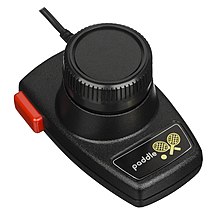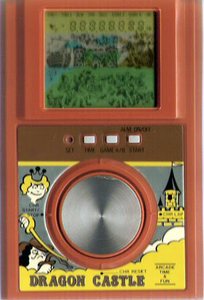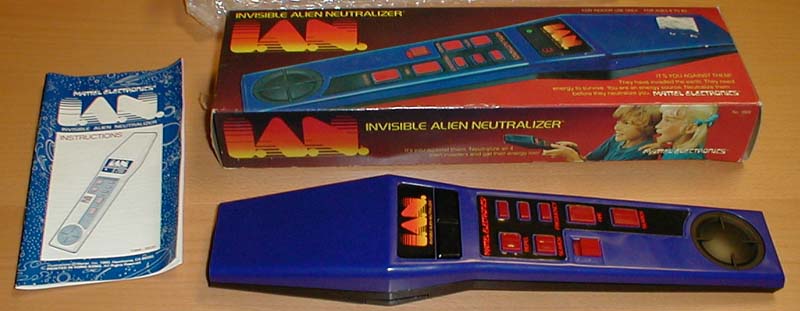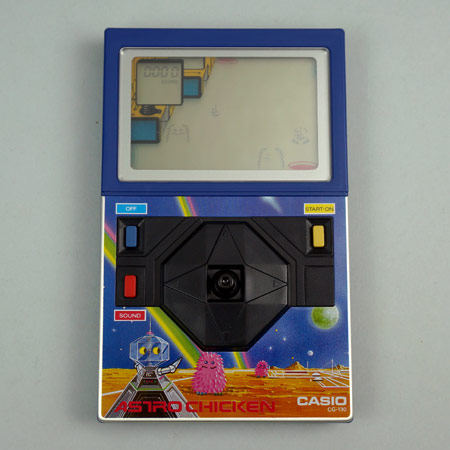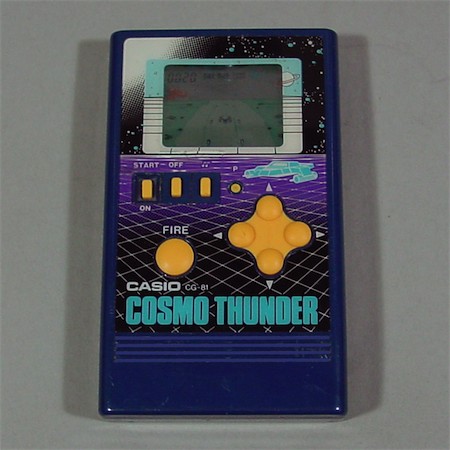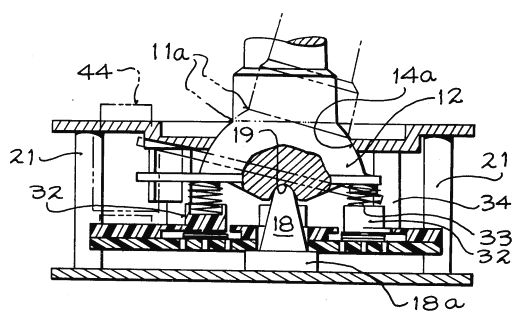Could you share these sources with us then? Gaming Historian provided some information, he even showed how Nintendo patented this. So i'm curious to see the evidence against that.
Sure. To start, just a quick reminder of how the Nintendo version works (shots taken from the video you linked in the OP): The user-manipulated control surface has a plus shape on top of a solid plate. On the underside of the plate is a hemisphere, set down into a cup to allow gimbaling. Under the plate is a sheet of conductive rubber, with bumps in each of four primary directions. When the plate is pushed down on that side, the corresponding bump is collapsed, closing a circuit on a contact membrane below it.
This is contrasted with earlier devices that used four individual buttons hit by the user, like in these handheld games:
But in fact, handheld games tried out so many control schemes that we can easily find multiple d-pad designs, both prior to and contemporaneous with Nintendo's Game & Watch "plus controller".
Here's a solid disc from 1981.
Also from 1981, here's a cool Tron game with an incised disc to indicate directions.
The earliest portable d-pad I've seen was from an electronic Mattel toy (not a videogame) from 1980. The pad is a circular dome, with rays to indicate the primary directions.
Here's a stylish 1982 Casio handheld, again with a circular control surface, but explicitly broken into 8-way zones with individual divots.
Here's another Casio game, from 1983 with an octagonal d-pad. Apart from the planar shape, it also changes the Nintendo version by being convex rather than concave.
Here's a 1982 game with a square d-pad split into quadrants.
And there were also explorations of cross shapes not exactly like a plus,
such as this 1983 one.
There are even early control schemes that are essentially a "virtual d-pad".
Tomy had a 1980 line of slim games with four long buttons arranged in a plus shape. But note the raised hard plastic nub in the center.
Obviously, the user is not meant to press the buttons individually by fingertip. Instead, it's clear that bump is to rest your thumb there, and just rock it toward the buttons to depress them. Thus the player's thumb is working like the d-pad plate, gimbaling to make contact on switches.
And of course, preceding all of these was the non-portable Intellivision. Like the OP video says, its d-pad felt loose and squirrelly...but mechanically it was essentially the same idea. The underside of the control disc had a central hemisphere, which allowed it to gimbal. Instead of pressing on conductive rubber to make contact with a membrane below, it presses on one membrane to make contact with another one folded below it. Compare these pictures to the Nintendo ones I started the post with.
(Some of these are from the later Intellivision III console because they show features more clearly, but this original Intellivision breakdown shows there's no material difference.)
Most of these versions came before
G&W DK, although a couple released slightly later. But together they show that every company in this crowded field was actively revising their controls repeatedly, searching for novelty and functionality. As noted in the OP video, Nintendo themselves skipped the "plus controller" in some later handhelds, all the way up through 1986. (Not to mention in the new Nintendo Switch.)
So if all this experimentation and usage was going on, beginning years earlier, then how did Nintendo manage to patent the d-pad? The answer comes from what patents typically are: not general ideas, but very specific descriptions of exact engineering solutions to specified design challenges. Though some wider patents are granted (the wisdom of this being a topic for another time), most are narrow, taken to apply to a very small range of devices, not varying in any meaningful way from instantiations given in the patent. For this reason, they often cite earlier patents in order to clearly differentiate themselves from similar prior art. Let's look at the patents Nintendo references in their d-pad filing.
First is
this Bell Labs patent from 1961, for a telephone control device that takes the form of the familiar dial, but instead actuates switches for much less complex innards. (The interior of a rotary phone is actually an amazing marvel of miniature electro-mechanical engineering. As an aside, I highly recommend
this James May show about it.) The described mechanism is still quite complicated, but this picture clearly shows an operating idea that's an obvious precursor to a d-pad.
The following reference is for
a 1975 pen with a calculator in it. With limited space on the barrel for buttons, each one was a four-way switch. The attachment has become simpler than on the phone patent, now just a spring that allows the "button" d-pad to swing down and cause switch contact in four directions. Here's the whole assembly, to which I've added the cutaway at top left and some suggested alternate "button" configurations at lower right.
Next is
Atari's patent for the 2600 controller, from 1977. Again the mechanism has gotten simpler. Instead of being on top of a spring, it has a simple gimbal with the hemisphere on the baseplate and the socket on the control plate, opposite of Nintendo's later version. But just like the Nintendo design that'd follow, each button resists pressing (using a spring for Atari, rubber for Nintendo) until enough pressure forces it to complete a circuit.
Next is a reference to the Intellivision patent. As mentioned above, this does use the Nintendo-style gimbal, but again a spring instead of rubber applies tension. Next up is
a 1979 patent by an industrial firm for a plus-shaped d-pad. It explicitly states that not only can each arm be pressed, it's intended for the user to be able to keep their thumb or finger in a central divot and lean it to accurately actuate multiple inputs in rapid succession without looking (the tactile "levering" action which the OP video claims Nintendo invented). The design also includes the inscribed arrows Nintendo used on
G&W DK. And this plus-shaped d-pad also uses rubber-dome membrane switches to both provide resistance and complete the circuit, just as with Nintendo's design from years later. The only difference seems to be that it's pictured mounted on a pivot pin, not a ball-and-socket gimbal.
And that's where Nintendo's patent comes in. Here are the salient features of the d-pad hardware they describe;
- A plus-shaped control surface
- Operated by positioning a digit in the center and applying lateral pressure
- Causing the control surface to tilt via ball-and-socket gimbal
- But it's biased toward neutral position by rubber domes
- Which must be overcome to make contact with membrane switches
Every single one of these things had already been patented and was in use before Nintendo applied. I presume the only way they could make their patent unique enough to get it granted was by combining all of these features together into a single device. There's a very informative detail regarding this revealed on
the official patent page.
Nintendo originally applied for this patent in 1983,
and it was not granted. The patent they hold is from when they re-applied in 1985. Though the earlier application doesn't seem to be available, I strongly suspect it was rejected because it wasn't specific enough to differentiate from all the prior art. Nintendo had to add further detail, making their version patentable but also eliminating their ability to stop very similar approaches to the same problem. Hence why d-pads continued to appear on competitors' machines.
In summary, Nintendo did not invent the d-pad, not even close. They were part and parcel of a burgeoning industry that was constantly experimenting with control schemes and manufacturing methods. Out of that chaos they developed one narrowly-defined combination of factors that happened to be included in an extremely successful consumer product, making their version most people's first exposure to the general idea of d-pads. Their method wasn't first, and wasn't necessarily best--some folks believe Sega or Sony have done better d-pads--but it was part of a breakout hit.
P.S. Note that all the above totally ignores the existence of joystick hat switches in aircraft. These have clear affinities and undoubted influence on both d-pad and thumbstick development. I don't know when they were invented, and didn't want to spend the time researching, but they predate everything in this post by decades at least. Here's a picture of the cockpit of an F-100 Super Sabre, developed in the early 1950s. The hat switch is the circular control on the right rear of the joystick.





